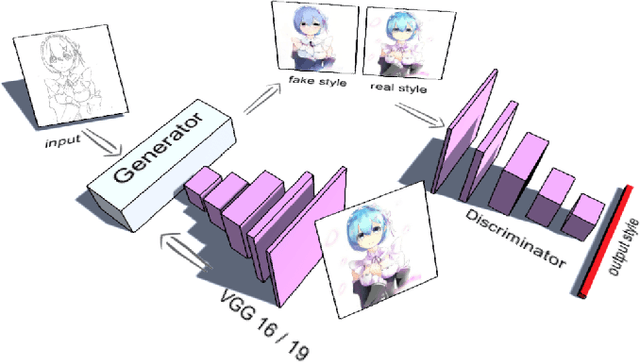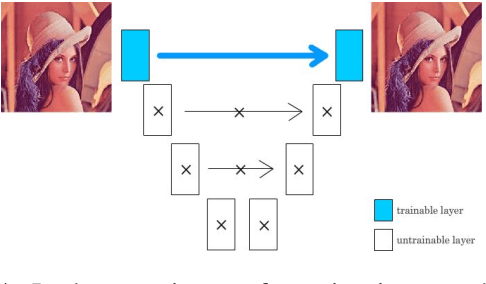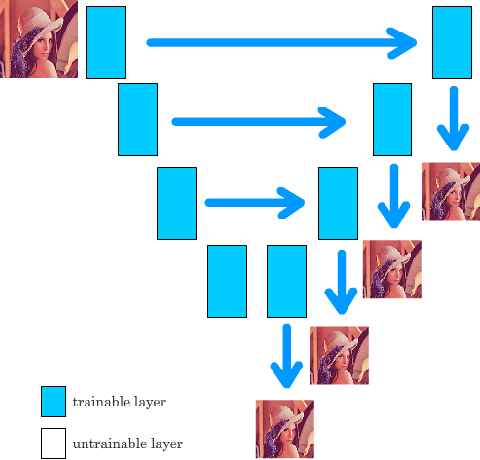Lvmin Zhang
Instance Segmentation of Scene Sketches Using Natural Image Priors
Feb 13, 2025Abstract:Sketch segmentation involves grouping pixels within a sketch that belong to the same object or instance. It serves as a valuable tool for sketch editing tasks, such as moving, scaling, or removing specific components. While image segmentation models have demonstrated remarkable capabilities in recent years, sketches present unique challenges for these models due to their sparse nature and wide variation in styles. We introduce SketchSeg, a method for instance segmentation of raster scene sketches. Our approach adapts state-of-the-art image segmentation and object detection models to the sketch domain by employing class-agnostic fine-tuning and refining segmentation masks using depth cues. Furthermore, our method organizes sketches into sorted layers, where occluded instances are inpainted, enabling advanced sketch editing applications. As existing datasets in this domain lack variation in sketch styles, we construct a synthetic scene sketch segmentation dataset featuring sketches with diverse brush strokes and varying levels of detail. We use this dataset to demonstrate the robustness of our approach and will release it to promote further research in the field. Project webpage: https://sketchseg.github.io/sketch-seg/
Transparent Image Layer Diffusion using Latent Transparency
Mar 01, 2024Abstract:We present LayerDiffuse, an approach enabling large-scale pretrained latent diffusion models to generate transparent images. The method allows generation of single transparent images or of multiple transparent layers. The method learns a "latent transparency" that encodes alpha channel transparency into the latent manifold of a pretrained latent diffusion model. It preserves the production-ready quality of the large diffusion model by regulating the added transparency as a latent offset with minimal changes to the original latent distribution of the pretrained model. In this way, any latent diffusion model can be converted into a transparent image generator by finetuning it with the adjusted latent space. We train the model with 1M transparent image layer pairs collected using a human-in-the-loop collection scheme. We show that latent transparency can be applied to different open source image generators, or be adapted to various conditional control systems to achieve applications like foreground/background-conditioned layer generation, joint layer generation, structural control of layer contents, etc. A user study finds that in most cases (97%) users prefer our natively generated transparent content over previous ad-hoc solutions such as generating and then matting. Users also report the quality of our generated transparent images is comparable to real commercial transparent assets like Adobe Stock.
Adding Conditional Control to Text-to-Image Diffusion Models
Feb 10, 2023Abstract:We present a neural network structure, ControlNet, to control pretrained large diffusion models to support additional input conditions. The ControlNet learns task-specific conditions in an end-to-end way, and the learning is robust even when the training dataset is small (< 50k). Moreover, training a ControlNet is as fast as fine-tuning a diffusion model, and the model can be trained on a personal devices. Alternatively, if powerful computation clusters are available, the model can scale to large amounts (millions to billions) of data. We report that large diffusion models like Stable Diffusion can be augmented with ControlNets to enable conditional inputs like edge maps, segmentation maps, keypoints, etc. This may enrich the methods to control large diffusion models and further facilitate related applications.
Style Transfer for Anime Sketches with Enhanced Residual U-net and Auxiliary Classifier GAN
Jun 13, 2017



Abstract:Recently, with the revolutionary neural style transferring methods, creditable paintings can be synthesized automatically from content images and style images. However, when it comes to the task of applying a painting's style to an anime sketch, these methods will just randomly colorize sketch lines as outputs and fail in the main task: specific style tranfer. In this paper, we integrated residual U-net to apply the style to the gray-scale sketch with auxiliary classifier generative adversarial network (AC-GAN). The whole process is automatic and fast, and the results are creditable in the quality of art style as well as colorization.
 Add to Chrome
Add to Chrome Add to Firefox
Add to Firefox Add to Edge
Add to Edge